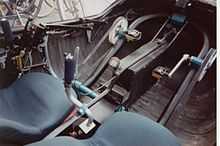Twike

The Twike (a contraction of "TWin" and "bIKE") is a human-electric hybrid vehicle (HEHV) designed to carry two passengers and cargo. Basically a velomobile with an electrical hybrid engine,[2] it can be driven in electric-only mode or electric + pedal power mode. Pedaling extends the range of the vehicle but does not substantially add to the vehicle's top speed.
Constructed of lightweight materials such as aluminium and plastic, the 246 kg (542 lb) (unladen) tricycle vehicle uses a lithium-mangan battery. Ranges of 300 miles are possible. Additional energy is reclaimed while driving through regenerative braking, and load is removed from the electric system by use of the pedalling system which transfers its input directly to the drivetrain (i.e., both systems operate in parallel, not in series).
Description

The Twike is a three-wheeled two seater. It is steered by cables and has pedal brakes. The vehicle can reach speeds of up to 85 kilometers per hour (53 mph), using 7.4 kWh per 100 km. At 50 km/h it can drive up to 80 km.[3]
History

The TWIKE I was developed for the 1986 World EXPO in Vancouver, Canada, by a group of Swiss students. It won the "Functionality Award" for the best ergonomic design in the Innovative Vehicle Design Competition (IVDC) and a first prize in the International Human Powered Vehicle Speed Championship . The TWIKE I was completely driven by human power.[citation needed]
Inspired by the success of the TWIKE I, a group of enthusiasts including Ralph Schnyder and Peter Zeller began to develop the TWIKE II as a step towards a vehicle for everyday road use. It was developed in cooperation with Alusuisse-Lonza Holding, was shown on the HEUREKA exhibition in Zürich, and took part in the 1991 Tour de Sol Alpin. The TWIKE II had a belt pedal drive with infinitely variable mechanical transmission and a DC motor powered by NiCd batteries to help propel the vehicle. The suitability for everyday use turned out to be significantly improved.[citation needed]
In 1992, the newly founded TWIKE Ltd. decided to develop the TWIKE II into a production vehicle and began looking for capital and customers. Production of the TWIKE III began in 1995 and during 1996 the reformed TWIKE AG produced and sold 190 vehicles, mostly in Switzerland and Germany. The TWIKE III was already equipped with an asynchronous AC motor and 336V NiCd batteries, the system still in use today. The pedal drive was simplified to a 5-speed hub gear and was included in all but very few special order vehicles.
In 1998, FINE Mobile GmbH launched its German TWIKE production line and finally became the exclusive producer of the TWIKE after taking over the rights of the SwissLEM AG in 2002. Today the TWIKE is produced in Rosenthal, a small village in Hessen near Marburg. Pricing for a TWIKE starts at about 25.000 € (basic version, two battery packs included).[citation needed] By 2011, 900 were claimed to have been sold.[4]
In the same city, team TW4XP announced their entry into the Automotive X Prize with their Twike-based TW4XP human-electric hybrid vehicle.[5]
See also
- Sinclair C5 - Another pedal/battery three-wheeled vehicle
- Velomobile
- Velotaxi
References
- ↑ Greenfleet.info
- ↑ Linde, Arvid. Electric Cars – The Future is Now!. Veloce. p. 87. ISBN 9781845844981.
- ↑ Hoogma, Remco; Kemp, Rene; Schot, Johan; Bernhard Truffer (2005). Experimenting for Sustainable Transport: The Approach of Strategic Niche Management. Routledge. pp. 107–8. ISBN 9781134488223.
- ↑ Boxwell, Michael (2011). The 2011 Electric Car Guide. Greenstream. p. 63. ISBN 9781907670060. Retrieved 6 February 2014.
- ↑ "Team TW4XP". Retrieved 6 November 2009.